Colchicum
Colchicum L. = Androcymbium Willd.
Family: Colchicaceae
Common names: cup and a saucer, men-in-a-boat (Eng.); bobbejaanskoen (Afr.)
Introduction
Members of the genus Colchicum are low, short-stemmed to stemless perennials with leaves spreading on the ground. The most noticeable characteristic of the southern African species are their large, often colourful bracts, which are upright, forming a cup that embraces the flowers.

Description
Description
The name is derived from the Greek word, kolkhikon, referring to Colchis, an ancient region east of the Black Sea. Species of the genus Colchicum are short-stemmed or stemless reaching a the height of 150 mm. All species have an ovoid corm (a corm unlike a bulb, is a stem that is swollen and modified for storage, flattened on top and slightly concave on the bottom: when upon being cut, the corm appears solid). It has a fan-like, basal fold, and is covered with dark leathery to woody tunics.

Leaves are few to several, and scattered along the stem or, in the stemless species, congested and often prostrate, ovate to linear-lanceolate, clasping below, parallel-veined, often with a distinct midrib; when broad, the leaves are arching. They have a soft leathery texture and the margins are sometimes crisped and smooth or ciliolate or bristly.
The inflorescence is single to few-flowered, bracteate and usually forming a congested raceme; the bracts are leaf-like or broader and often coloured or patterned, the inner bracts are successively smaller. The flowers are found at the base of the bract and are usually green-white. There are six tepals (rarely 7–12), which are not joined to form a tube. They have a swollen yellow nectary at the base. The six stamens are attached to the lower part of the tepals. The ovary is cylindrical; deeply lobed, has three free styles and many ovules per locule. The fruit is an ovoid capsule that spilts open along the edges of each chamber (septicidal). Most of the Cape species have curious, cupped tepal limbs, which hold the nectar, and often broad, colourful floral bracts that resemble large petals, which envelope the small flowers.
Conservation Status
Status
Few members of the genus are listed on the red data listed on the red data in Strelitzia 4 (Hilton-Taylor 1996). I believe the reason why only a few specimens have been collected is because of the flowering time which is during winter when there are few plant collecting activities.
Distribution and habitat
Distribution description
These plants previously belonged to the genus Androcymbium but have since been included in Colchicum, which is the older name. DNA studies show that the species of Colchicum represent a single, specialised lineage or group that evolved from an ancestor within the genus Androcymbium. As such both genera must be included within one.
There are over 100 species found mostly in and around the Mediterranean on the Iberian Peninsula, North Africa and the Mediterranean climate zone of South Africa, 13 of which occur in the Western Cape. Most species occur in the western Karoo and Namaqualand, which lie to the north of the Cape Floral Region.
Ecology
Ecology
Species are found in sandy soil, most frequently near coastlines and also heavy clay soils inland. The location of the nectaries on the tepals does not favour the development of a floral tube; therefore various genera of the family Colchicaceae exploited a diversity of other unfamiliar pollinators such as small flies, wasps, beetles, butterflies and possibly rodents.
Southern African species of Colchicum are of limited horticultural appeal, but some species such as the Namaqualand C. capense subsp. ciliolatum and C. coloratum subsp. coloratum are a charming sight as the late afternoon light slants though their pale or reddish, sail-like bracts. Colchicum is long-lived, reaching at least 20–25 years of age in European species.
Uses
Use
The bulb of Colchicum has been found to be toxic, yet it has been used medicinally by the Southern Sothos as ointment for the sore ears. The plant is believed to be a charm to stop the enemy in wars.
Growing Colchicum
Grow
Being mostly plants of the winter rainfall region in the Mediterranean and in southern Africa, most require moisture during the winter months, but none in summer. Species from the summer rainfall region will require the reverse. They need a well-drained soil with more sand than humus as well as a warm spot in full sun with a dry resting period when they are dormant. Stop watering as soon as the foliage starts dying back at the end of the growing season.
In frost free areas with winter rainfall, a spot in the rock garden is a most suitable place to cultivate and display most of the species outdoors.
Plants can also be grown in deep containers in a well drained medium.
Colchicums can be propagated from fresh seed. The seed will ripen very quickly in hot, dry weather. Bryan (1989) advises planting immediately in well drained soil in pots, then separating to individual pots when large enough to handle and the following spring transplanting into the rockery.
It is more usual to plant the seed of winter growing geophytes in autumn (fall) at the commencement of the growing season, and to transplant the corms when dormant.
Plants will take about 4 years to flower if grown from seed. Plants can also be grown in pots without bottoms which are sunk into the rockery.
These plants can also be increased by separating the cormels or offsets from the corms. This can be done as soon as the foliage has died down in early midsummer or before growth commences.
Species
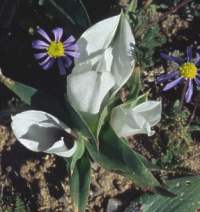
C. coloratum subsp. burchellii (Baker) J.C. Manning & Vinnersten
Plants without stem, leaves ovate-lanceolate, 45–125 x 23–70 mm, often with small hairs but usually smooth, about 2–4 flowers enclosed in white, rounded bracts, sometimes bracts are greenish at apex but mainly white, tepal blades concave at the base, shorter than the tepal claw, stamens twice as long as tepal blades. Flowering time: June–August . Plants are found in stony flats in the western Karoo and Bokkevelds Mountains at 600–1 000 m altitudes.
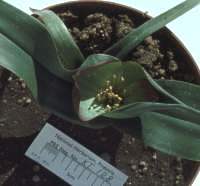
C. capense (L.) J.C. Manning & Vinnersten subsp. capense
The plants are found growing amongst short grass and have no stem, Leaves usually 3 or 4, spreading or prostrate, ovate-lanceolate to lanceolate, often with wavy, hairy margin, leathery, 40–150 mm long, bracts broadly ovate, green above but marked with white below or mostly white not striped, 50–80 mm high and wider than the leaves, flowers 2–5, tepal blade concave at base more or less as long as the tepal claws, tepal claws 8–10 mm long, filaments 5–7 mm long, styles as long as or slightly longer than ovary. Flowering time: May–August. (March–April in the northern hemisphere). Plants grow on clay or loam flats in the southwestern Cape.
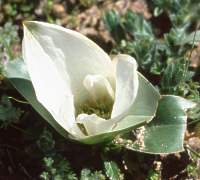
C. capense subsp. ciliolatum (Schltr. & K.Krause) J.C. Manning & Vinnersten
Stemless geophyte up to 0.1 m tall, leaves ovate-lanceolate, 55–145 x 14–47 mm, lying on the ground, the margin of the leaves are ciliolate, bracts pale green to white covering white flowers, tepal blade concave at the base and shorter than the tepal claw, stamens longer than the tepals. Flowering time: June–August. Plants are found in the Northern Cape and Western Cape in Namqualand on Atlantic coast.
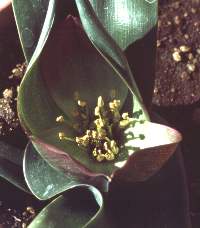
C. hantamense (Engl.) J.C. Manning & Vinnersten
Stemless geophyte, leaves lanceolate, 90–230 x 10–60 mm, margin ciliate, 2–5 flowers enclosed in large white bracts which are sometimes striped in green. Tepal blades concave at the base, almost twice as long as the tepal claw, stamens almost as long as the tepals. Flowering time: June–August. Plants grow on clay or loam flats on the Hantam Plateau around Nieuwoudtville southwards to Clanwilliam in the southwest.
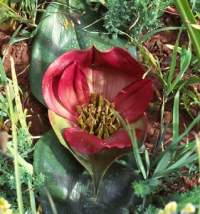
C. coloratum J.C. Manning & Vinnersten subsp. coloratum
Plants without stem. Two flat leaves, 48–180 x 20–80 mm, never curled, and generally smooth sometimes with small hairs, bracts ovate to round, purplish red, with green bases and 1–5 pinkish flowers. Tepal blades concave at the base, shorter than the tepal claw, stamen twice as long as tepal blades. Flowering time: July–August. The plant is found in the western Karoo and Bokkeveld Plateau.
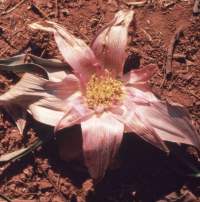
C. melanthioides (Willd.) J.C. Manning & Vinnersten
Plants with or without a visible stem, 100–200 mm high. Leaves suberect, lanceolate to linear-lanceolate, channeled, 100–300 mm long, bracts ovate-lanceolate, creamy white to pinkish with green veins. Flowers 3–7, stalked, tepal blade concave at base, more or less as long as the tepal claws, stamen slightly as long as the tepal blade. This species is subdivided into three subspecies of which two are dealt with here:
C. melanthioides (Willd.) J.C. Manning & Vinnersten subsp. melanthioides
Tepal may reach 12–18 mm in length. Flowering time: May–August in Mpumalanga and Swaziland , February–April in northern Namibia at 645–2 500 m altitudes.
C. melanthioides subsp. transvaalense (U.Müll.-Doblies & D.Müll.-Doblies) J.C. Manning & Vinnersten
Tepal may reach 10–12 mm in length. Flowering time: January–March in Mpumalanga and Swaziland at 1 100–2 000 m altitudes.

C. roseum (Engl.) J.C. Manning & Vinnersten
Perennial geophytes up to 0.03 m tall. Leaves several, linear-lanceolate up to 135 x 5 mm. Flowers 2–20 in a cluster, pink or pink-streaked and protruding above the crown in a rosette habit. Tepal blades flat, stamens shorter than tepals. Flowering time: May–June. Plants grow on seasonally waterlogged depressions in clay soil and are found in southwestern Northern Cape, Namibia, Botswana, Angola, and Zimbabwe.

C. striatum (Hochst. ex A.Rich.) J.C. Manning & Vinnersten
Stem extended above the ground, the plants are 150–350 mm tall, leaves 100–185 x 3–14 mm, bracts with longitudinal grooves, white and strongly striped with green, surrounding 3–9 flowers, tepal blades concave at the base, twice as long as the tepal claw, stamen almost as long as the tepal blade. Flowering time: July to August. Plants grow in high rainfall grassland on rock crevices, distributed world-wide, from South Africa (Western Cape, Eastern Cape, Free State, Gauteng, Lesotho, Mpumalanga and Limpopo) to Ethiopia.
References
- Bryan , J.E. 1989. A–H bulbs , vol. 1. Timber Press, Portland, Oregon.
- Doutt, R.L. 1994. Cape bulbs . Timber Press, Portland, Oregon.
- Goldblatt, P. & Manning, J. 2000. Cape plants. A conspectus of the Cape flora of South Africa . Strelitzia 9. National Botanical Institute, Cape Town
- Kubitzki, K. 1998. The families and genera of vascular plants , vol. 3. Springer-Verlag, Berlin, Heidelberg.
- Manning, J., Forest, F. & Vinnersten, A.2007. The Genus Colchicum L. redefined to include Androcymbium Willd. based on molecular evidence. Taxon 56(3): 872-882.
- Manning, J., Goldbaltt, P. & Snijman, D. 2002. The color encyclopedia of Cape bulbs. Timber Press, Portland, Cambridge.
- Müller-Doblies, U. & Müller-Doblies, D. 1998. De Liliifloris Notulae 6: De decuria prima specierum novarum generis Androcymbium sect. Androcymbium (Colchicaceae) in Africa Australis. Feddes Repertorium 109: 551–572.
- Müller-Doblies, U. & Muller-Doblies, D. 2002. De Liliifloris Notulae 7: De decuria altera specierum novarum generis Androcymbium (Colchicaceae) in Africa Australis. Feddes Repertorium 113: 545–599.
- Sterling , C. 1973. Comparative morphology of the carpel in the Liliaceae: Colchicaceae (Androcymbium ). Botanical Journal of the Linnean Society 67: 149–156.
- Watt, J.M. & Breyer-Brandwijk, M.G. 1962 Medicinal and poisonous plants of southern and eastern Africa. Livingstone, Edinburg & London.
Credits
E.T. Rampho
Pretoria National Herbarium
January 2006
Updated July 2008
Plant Attributes:
Plant Type: Bulb
SA Distribution:
Soil type:
Flowering season:
PH:
Flower colour:
Aspect:
Gardening skill:
Special Features:
Horticultural zones






Rate this article
Article well written and informative
Rate this plant
Is this an interesting plant?
Login to add your Comment
Back to topNot registered yet? Click here to register.